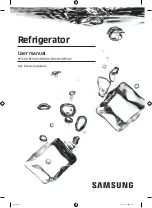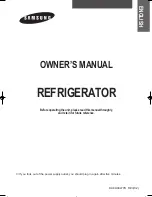
- 73 -
9-6 REFRIGERATION CYCLE
▼
Troubleshooting Chart
PARTIAL
LEAKAGE
Freezer
compartment and
Refrigerator don't
cool normally.
Low flowing sound of
Refrigerant is heard
and frost forms in
inlet only.
A little higher than
ambient
temperature.
• Refrigerant level is low due
to a leak.
• Normal cooling is possible by
restoring the normal amount
of refrigerant and repairing
the leak.
COMPLETE
LEAKAGE
Freezer
compartment and
Refrigerator don't
cool normally.
Flowing sound of
refrigerant is not
heard and frost isn't
formed.
Equal to ambient
temperature.
• No discharging of
Refrigerant.
• Normal cooling is possible by
restoring the normal amount
of refrigerant and repairing
the leak.
LEAKAGE
PARTIAL
CLOG
Freezer
compartment and
Refrigerator don't
cool normally.
Flowing sound of
refrigerant is heard
and frost forms in
inlet only.
A little higher than
ambient
temperature.
• Normal discharging of the
refrigerant.
• The capillary tube is faulty.
WHOLE
CLOG
Freezer
compartment and
Refrigerator don't
cool.
Flowing sound of
refrigerant is not
heard and frost isn't
formed.
Equal to ambient
temperature.
• Normal discharging of the
Refrigerant.
MOISTURE CLOG
Cooling operation
stops periodically.
Flowing sound of
refrigerant is not
heard and frost melts.
Lower than ambient
temperature.
• Cooling operation restarts
when heating the inlet of the
capillary tube.
CLOGGED BY DUST
COMP-
RESSION
Freezer and
Refrigerator don't
cool.
Low flowing sound of
refrigerant is heard
and frost forms in
inlet only.
A little higher than
ambient
temperature.
• Low pressure at high side of
compressor due to low
refrigerant level.
NO COMP-
RESSION
No compressing
operation.
Flowing sound of
refrigerant is not
heard and there is
no frost.
Equal to ambient
temperature.
• No pressure in the high
pressure part of the
compressor.
DEFECTIVE
COMPRESSION
CAUSE
REMARKS
STATE OF THE
EVAPORATOR
TEMPERATURE
OF THE
COMPRESSOR
STATE OF
THE UNIT
12-6-1 Cleaning
There is no need for routine condenser cleaning in normal Home operating environments. If the environment is
particularly greasy or dusty, or there is significant pet traffic in the home, the condenser should be cleaned
every 2 to 3 months to ensure maximum efficiency.
If you need to clean the condenser:
●
Remove the mechanical cover.
●
Use a vacuum cleaner with a soft brush to clean the grille, the open areas behind the grille and the front
surface area of the condenser.
●
Replace the mechanical cover.
Summary of Contents for LMX28994 Series
Page 23: ... 23 5 CIRCUIT DIAGRAM ...
















































